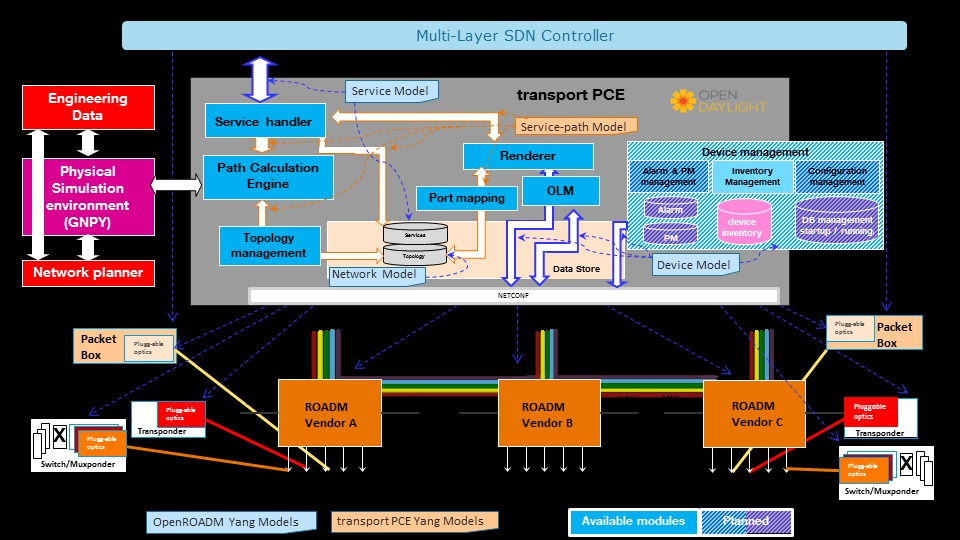Documentation
Getting Started for Users https://docs.opendaylight.org/projects/transportpce/en/latest/user-guide.html?highlight=transportpce
Getting Started for Developers https://docs.opendaylight.org/projects/transportpce/en/latest/developer-guide.html?highlight=transportpce
Presentations
Tech Work Stream Session 2020
View file name TransportPCE-ODL TWS 20200427.pdf height 250
Santa Clara Sodium DDF 2019
| View file | ||||
|---|---|---|---|---|
|
San Jose Open Networking Summit North America 2019
| View file | ||||
|---|---|---|---|---|
|
Amsterdam neon DDF 2018
| View file | ||||
|---|---|---|---|---|
|
Requirements
Release Planning
Release Notes
Magnesium
- Introduction of OTN
- OTN topology : management of OpenROADM OTN devices including switching pool
- Creation/deletion of OTN services using East/west APIs
- path-computation request, otn-service-path
- 1GE/ODU0, 10GE/ODU2e, ODU4, OTU4 services
- OTN rendering function (creation of OTN interfaces and cross connections on devices)
- T-API
Implementation of get-T-API-topology allows retrieving an abstracted topology derived from the
openroadm-topology and otn-topology layer (Nodes and access-points in SR0)
- Device inventory
- Experimental support of device inventory (limited to OpenROADM device 1.2.1 in Mg SR0)
- Interconnection to GNPy
- An interconnection to GNPy is fully supported, including:
- Topology export to GNPy tool and
CE Path validation Tech / impairment aware optical path calculation performed in GNPY according to specific constraints
- An interconnection to GNPy is fully supported, including:
Sodium
Sodium tPCE release focuses on code refactoring.
- Main goal is to get a robust base (fully tested) aligned with latest developments and bug corrections coming from the different contributors
- Hardened support of OpenROADM 1.2.1 and 2.2.1 releases
Full support of ietf network topology (RFC 8345 / openROADM Network model 4.1) with consolidated topology building and portmapping functions
- CI/CD environment allowing smooth integration of contributions avoiding regression (+/-1 voting)
Neon
The main features added in Neon release are the following:
- Add support for notification in RPC handling
Extension of the coverage for OpenROADM Service RPC handling: service-reroute, service-restoration, temp-service-create/delete
- Impairment aware path calculation in PCE (OSNR calculation)
- Management of unidirectional ports in path calculation and path configuration
- ROADM to ROADM service creation, for resource reservation when transponders are not present
- Introduction of transportpce-service-path 1.6
- Device version management (up to release 2.2.1)
Fluorine
- Provides most of the bricks defined in the controller architecture for the WDM layer
- Junit and functional tests developed for the available modules
- Continuous integration eases collaboration between contributors in different countries, entities & companies
Side-Projects
- Honeynode: a WDM / OTN device simulator based on FD.io honeycomb and used for TransportPCE functional tests
- TransportPCE GUI:
This GUI Provides a collapsed topological view of the OpenROADM network controlled by Transport PCE:- Backend interaction with TransportPCE Data store (ODL MD-SAL)
- Collapsed view based on CLLI, Network and topology layers
As well as a view of provisioned services
Based on Spring boot, Spring Data and Angular
More details and source code available at Orange opensource LFN gitlab space:
https://gitlab.com/Orange-OpenSource/lfn/odl
